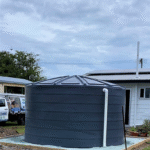It’s not merely about conserving water; it’s about selecting the ideal system that aligns with your lifestyle.
Throughout Queensland, an increasing number of homeowners are opting for rainwater tanks to reduce their utility expenses, alleviate pressure on local water supplies, and establish drought-resilient homes. However, before making an investment in a tank, a significant question arises: How much water do you really need?
At Creek to Coast Plumbing, we assist homeowners in designing more effective rainwater harvesting systems, and selecting the appropriate tank size is a vital initial step in this process.

Maximise Your Rainwater Collection Potential
Begin by evaluating your rainwater collection potential. This potential hinges on two primary factors: your roof area and the average annual rainfall in your locality. Understanding these components is critical to effective planning.
Let’s delve into the specifics:
- For every square metre of roof space, you can typically collect about 1 litre of water for every 1mm of rain.
- If your roof spans 200m² and your area receives 1,200mm of rain each year, that translates to 240,000 litres annually (theoretical maximum).
However, it’s essential to recognise that this is an ideal scenario. In practical situations, you will experience water loss due to factors such as first flush systems, evaporation, roof slope, gutter design, and overflow.
We generally advise planning for a collection efficiency of 80–90%.
What Are Your Plans for Using the Collected Water?
This is where practical considerations come into play. Are you collecting rainwater solely for garden use, or do you intend to supply it to toilets, laundry facilities, or even your entire home?
Here are some key considerations to keep in mind:
Optimal Sizing for Garden Irrigation
If your primary goal is to irrigate lawns, vegetable gardens, or ornamental plants, a small to mid-sized tank (2,000–5,000 litres) should suffice.
However, the decision largely depends on the size of the garden and the prevailing local rainfall patterns.
Frequent short bursts of heavy rain often necessitate larger tanks to capture as much as possible when it pours.
Utilising Rainwater for Laundry and Toilet Purposes
Homes that incorporate rainwater for toilets and washing machines often find that 5,000–10,000 litre tanks provide substantial benefits. These appliances account for approximately 35–40% of internal water consumption, so this can lead to significant cost savings.
It's necessary to include a pump and suitable plumbing to integrate these systems with your household, a service that Creek to Coast expertly manages as part of our installation process.

Considerations for Whole-House Water Supply
If you aim to go completely off-grid or provide rainwater to every tap in your home, you will likely require 20,000 litres or more, contingent upon the size of your household. Larger tanks can also serve as backup in case of fire emergencies, during periods of low rainfall, or when accommodating guests.
How Many Residents Are in Your Home?
A solid guideline suggests providing around 150–250 litres per person per day when using rainwater for general household purposes.
- For a couple: a 5,000–10,000 litre tank should be adequate.
- For families of 4 or more: consider 10,000–20,000 litres or larger.
The number of occupants in your home directly affects how quickly your tank will be depleted, particularly during dry spells when water conservation becomes even more critical.
Is Your Roof Area Sufficient for Rainwater Harvesting?
The size of your roof plays a pivotal role in determining how much water you can effectively collect.
A larger roof equates to greater harvesting capabilities.
However, the layout is equally important. If you have multiple roof sections that can connect to a single tank, we can help you devise a smart downpipe system to maximise water capture from all available surfaces.
For smaller homes or townhouses, slimline or under-deck tanks may be more suitable, and Creek to Coast can assist you in finding the perfect fit.

Essential Elements: Placement, Guttering, and Overflow Management
Effective rainwater harvesting extends beyond just the tank itself.
A robust system requires:
- Secure, well-maintained gutters that prevent clogging
- Leaf guards and first flush diverters to maintain water quality
- Overflow systems that direct excess water away from your home’s foundations
- A level, reinforced tank pad or stand for stability
Creek to Coast Plumbing provides comprehensive rainwater system installations, including gutter upgrades, pump connections, stormwater management, and filtration solutions to ensure your tank is secure and future-ready from the outset.
How to Ensure Cleaner and Safer Rainwater?
We highly recommend considering a whole-house rainwater filtration system, especially if you intend to use your tank for more than just garden irrigation.
The Puretec Hybrid Plus systems, expertly installed by our team, can effectively filter out sediments, odours, tannins, bacteria, and even adjust the water’s pH to mitigate copper leaching and pipe corrosion. Discover more about the benefits of water filtration for your tank water.
Making Informed Choices for Your Rainwater Tank
Selecting a rainwater tank is not merely about choosing the largest tank available; it’s about aligning your system with the size of your roof, the rainfall patterns in your area, and your specific water usage habits.
At Creek to Coast Plumbing, we have been assisting Queensland residents in establishing sustainable rainwater systems for over 30 years. From determining the right tank size and placement to complete guttering and filtration systems, we are committed to ensuring you maximise every drop of precious rainwater.



You raise a critical point about the multifaceted nature of rainwater harvesting systems, and how the choices we make can significantly impact both our finances and the environment. It’s interesting to see how rainwater tanks are becoming increasingly popular in Queensland, where the climate can be quite variable. This discussion about conservation goes beyond simply collecting rain; it touches upon a broader need for sustainable living practices that many homeowners are beginning to embrace.
It’s so true that selecting the right rainwater tank is crucial for homeowners, especially in a place like Queensland where water conservation is increasingly necessary. I’ve been thinking about this for my own home; the potential savings on utility bills alone make it worth considering. It’s interesting how much of our daily activities can change when we start to think about water as a precious resource rather than an unlimited supply.
I really appreciate how you highlighted the importance of not just installing a rainwater tank but choosing the right one for our individual needs. When I looked into rainwater collection for my home in Queensland, I realized how much the size of my roof and local rainfall really determines the benefits.
I really appreciate how you highlighted the importance of selecting the right rainwater tank system tailored to one’s lifestyle. The thought that goes into such a decision can indeed make a significant difference in both our daily lives and the health of our local environment.
I appreciate the focus on tailoring rainwater harvesting systems to individual lifestyles; it’s a crucial point that often gets overlooked. Personally, I live in a suburban area with a decent-sized yard, and we’ve recently installed a rainwater tank. It’s made a noticeable difference in managing our garden during the dryer months. However, selecting the right size did involve a fair bit of research—definitely something I wish I had more guidance on at the outset!